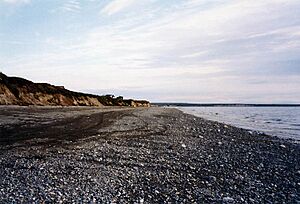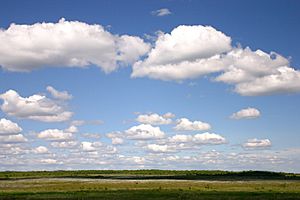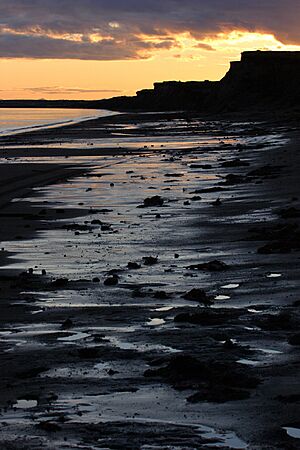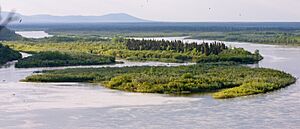Bristol Bay facts for kids
Bristol Bay (also called Iilgayaq or Залив Бристольский) is a large part of the Bering Sea in Southwest Alaska. It's like a big arm of the sea, about 400 kilometers (250 miles) long and 290 kilometers (180 miles) wide. Many rivers flow into Bristol Bay, including the Cinder, Egegik, Igushik, Kvichak, Meshik, Nushagak, Naknek, Togiak, and Ugashik rivers.
Some parts of Bristol Bay have very high tides, among the highest in the world. For example, near Dillingham and Naknek, the tides can change by more than 10 meters (30 feet)! This makes it tricky for boats to travel, especially with many shallow areas and strong winds. Bristol Bay is the shallowest part of the Bering Sea, which makes it one of the most challenging areas for large ships.
Contents
History of Bristol Bay
Long, long ago, much of Bristol Bay was dry land. It was part of the huge Bering land bridge that connected Asia and North America. Later, people started living along the bay because it had lots of valuable minerals, animals, and seafood.
Early explorers from Russia and England were the first non-native people to visit the area. In 1778, the famous British explorer Captain James Cook named the bay "Bristol Bay." He named it after the Admiral Earl of Bristol in England.
Early Settlements
In the late 1790s, the Russian American Company set up some temporary camps. They sent groups to explore and map the coast and inland areas of Bristol Bay. One group mapped the land between the Kuskokwim River and Nushagak River.
The original Eskimo village at Naknek had different names given by the Russians. An Aleut named Andrei Ustiugov created the first detailed maps of Bristol Bay in 1819. Russian Navy ships also explored the Bering Sea coast in the mid-1800s. They named many places we still use today, like Capes Constantine and Chichagof, and Mounts Veniaminof and Pavlof. The first salmon cannery opened in Bristol Bay in 1883.
In 1912, the Katmai Volcano erupted, and in 1919, a flu sickness spread. These events greatly affected the people and area around Naknek. Only about three original families were left, according to stories passed down.
World War Two and Fishing
On July 7, 1937, Japanese fishing boats with large trawlers came into Bristol Bay to catch salmon. At that time, American laws in Alaska did not allow motorized fishing boats, fish traps, or large nets called purse seines. This was to make sure enough salmon could swim upstream to lay their eggs, keeping the fish population healthy.
The Japanese boats were modern and powered by diesel engines. They had a big advantage over the American fishermen that summer. In 1938, the United States and Japan agreed that Japan would not fish in Alaskan waters. This agreement lasted until World War 2 began.
In the 1950s, Japan's fishing in the Pacific grew stronger. So, the US, Canada, and Japan signed the North Pacific Fisheries Treaty. This treaty helped manage the fish resources together. It was a model for how countries work together to protect fish for the future.
Industries of Bristol Bay
Bristol Bay is famous for having the world's largest number of Sockeye (red) salmon. It also has many Chum (dog) salmon, Coho (silver) salmon, Chinook (king) salmon, and Pink (humpy) salmon. These salmon come to the bay at different times of the summer.
Chinook salmon arrive first to lay their eggs, followed by Sockeye and Chum. Coho and Pink salmon come later in the summer. Fishing is busiest when the most salmon are moving from the ocean into Bristol Bay. Then they swim up the rivers to their freshwater spawning grounds.
Sockeye salmon are quite rare globally. Even though their numbers change each year, Sockeye salmon make up a small but important part of the world's salmon catch.
Commercial Fishing
Bristol Bay has the biggest salmon run in the world. All five types of Pacific salmon lay their eggs in the bay's freshwater rivers. The commercial fishing industry here is huge, especially for Sockeye salmon. Fishing for salmon and other fish like herring provides almost 75% of the jobs in the area.
For the first 50 years of commercial salmon fishing in Bristol Bay, boats could only use sails. In 1951, this rule changed. Within seven years, about 1,500 boats were updated with diesel or gas engines. A law passed in the late 1920s said boats could be no longer than 32 feet. This rule is still true today.
Canneries
Bristol Bay is a remote area. Canneries are factories that clean, gut, and process the salmon right there. This helps keep the salmon fresh. Many companies have set up canneries in Bristol Bay.
Some of these companies include North Pacific Seafoods, Peter Pan Seafoods, Trident Seafoods, and Ocean Beauty.

Besides commercial fishing and canneries, other important industries are sport fishing, hunting, and tourism. Many lodges for fishing and hunting have opened recently. Also, more people are visiting the nearby Katmai National Park and Preserve. Sport fishing is very popular, with many lodges for people who want to catch salmon and trout. Other freshwater fish include humpback whitefish, Dolly Varden trout, and Rainbow trout.
There has also been interest in finding oil and minerals in the area. One big project was the proposed Pebble Mine near Iliamna Lake. There were also plans to allow oil and gas drilling in the southern part of Bristol Bay. However, this area has been closed to drilling since 1998.
Communities of Bristol Bay
The largest town in the Bristol Bay area is Dillingham. Many other communities are located along the coast and rivers of Bristol Bay. These include:
- Aleknagik
- Chignik
- Chignik Lagoon
- Chignik Lake
- Clark's Point
- Egegik
- Ekuk
- Ekwok
- Igiugig
- Iliamna
- Ivanof Bay
- King Salmon
- Kokhanok
- Koliganek
- Levelock
- Manokotak
- Naknek
- New Stuyahok
- Newhalen
- Nondalton
- Pedro Bay
- Perryville
- Pilot Point
- Pope-Vannoy Landing
- Port Alsworth
- Port Heiden
- Portage Creek
- South Naknek
- Togiak
- Twin Hills
- Ugashik
Most of these communities are mainly home to Alaska Natives. However, Dillingham and King Salmon have a mix of people. Dillingham was influenced by salmon cannery workers from around the world. King Salmon was settled by military people and later by visitors and workers for Katmai National Park and Preserve.
Proposed Pebble Mine
A large mining project called the Pebble Mine was proposed in the Bristol Bay area. It aimed to dig for copper, gold, and molybdenum. Companies like Rio Tinto Group and Mitsubishi were involved. Northern Dynasty Minerals LLC started the project in 2001 and invested a lot of money. However, they lost their partners by 2011 because of new government rules and concerns.
Many people worried about the mine's impact on Bristol Bay's wildlife and people. The mine would create billions of tons of waste. This waste would need to be stored in an area that often has earthquakes. Environmental groups were also concerned about Rio Tinto's past environmental record.
In 2003, the U.S. Environmental Protection Agency (EPA) looked into how the mine might affect fish, wildlife, and native Alaskan tribes. The mining company sued the EPA several times, saying the EPA made unfair assumptions.
In 2019, the EPA removed its plan to stop the mine. However, in 2020, activists secretly recorded conversations with the mine's leaders. The leaders talked about how they planned to get politicians to support the mine. They also said the mine could last for 160 years, even though they were only asking for a 20-year permit.
After more than 20 years of opposition from most Bristol Bay residents and Native Tribes, the EPA used its power under the Clean Water Act to stop the Pebble Mine project. The EPA decided that after much research, the mine would cause too much harm to the salmon fishing areas in Bristol Bay.
See also
 In Spanish: Bahía de Bristol para niños
In Spanish: Bahía de Bristol para niños





